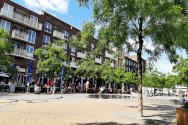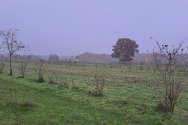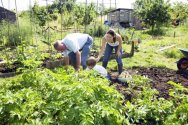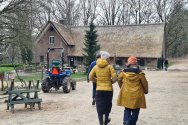Team LUF: Land Use and Food Security
Team LUF contributes to healthy farming and food systems, starting from people and nature – in the Netherlands and internationally.
Our research contributes to sustainable farming and food systems. We depart from the potentials and needs of people and nature in order to advance sustainable land use and food security. We analyze, design, optimize, co-create and synthesize knowledge on farming systems in the context of the natural environment and society. Systems thinking is our basis and the holistic perspective of agroecology the leading concept.
Our research on biodiversity and agriculture focuses on changes in land use and management and its effects on biodiversity, ecosystem services and agricultural production. We work on species-rich permanent grassland, agroforestry, trees and hedges, functional agro-biodiversity and nature conservation on farmland, as well as in cities. In several studies we deal with the integration of agricultural production with other societal sectors, such as electricity generation, care, education and public health. In citizen initiatives and short food chains we study the links between production and consumption.
We work on climate adaptation and mitigation in crop production and explore whole farms’ and landscape circularity, and carbon farming approaches. We are advancing regenerative development as a living systems approach to transform people’s stance towards land, soil, people, knowledge, water and biodiversity. Our quantitative system analyses explore the prerequisites and potential outcomes of agricultural transition.
Researchers of the team LUF are mainly active, but not restricted to working in AGRO’s Dynamic Expertise Groups: International, Agroecology & Biodiversity, Social & Transition Sciences, Soil & Climate, Grassland, Agrivoltaics.
Agrivoltaics
Agrivoltaics, or agri-PV, is the combination of solar panels with agriculture on the same plot and is a form of multi-purpose land use that can add value by preserving farmland and using land more efficiently. Synergy is possible when the solar panels replace existing crop protection covers or nets, and in dry years when the reduced evaporation in agri-PV gives higher yields. Besides these advantages, there are also downsides: the investment in agrivoltaics is higher than for a standard monofunctional solar farm, crop yields go down when there is too much shade, and in open crops, the cultivable area is reduced because cultivation cannot take place right next to the panel structure. In projects with fruit (raspberries, strawberry, pear, redcurrant) and productive grassland, all the different aspects of agrivoltaics are integrated: the distribution of light over PV and crop with effects on yields, the (cultivation) technical side, financial aspects and policy aspects.
More about agrivoltaics
- Position paper: Producing food and electricity on the same. Researchers see a future for agricultural solar parks, but also challenges
- Wageningen Solar Research Programme
- Sunbiose Project
- Experts call for a clear definition of Agri-PV
Would you like to know more about agrivoltaics? Ask our expert:
Biomonitoring: measuring air quality with plants
Industries that release airborne particulates must meet strict emission standards set by the Dutch government. Even so, farmers and local residents still routinely question whether these emissions are ending up in their immediate surroundings. Biomonitoring - using plants to measure air quality - addresses the concerns of area farmers and residents.
Indicator plants
Some plants, being highly sensitive to air quality, develop visible and specifically attributable symptoms. Cultivating these so-called 'indicator plants' in at-risk areas facilitates local air-quality monitoring. Plants that absorb and store airborne particulates without developing visible symptoms are known as 'accumulators'. Samples collected from these plants can be analysed for substances such as heavy metals, PAHs, dioxins and PCBs. Biomonitoring has been shown to be a powerful tool for monitoring air quality near waste incinerators, ore processing plants and airports.
Biomonitoring as a prevention measure
Biomonitoring measurement points were set up around Lelystad Airport to determine the local air quality. At the same time, the future consequences of Lelystad Airport's planned expansion on crops in the immediate surroundings were determined by taking biomonitoring measurements near Bremen Airport, which, in terms of its activity levels, is comparable with the future Lelystad Airport. Based on these measurements, the aeroplanes' exhaust gas emissions did not appear to have an adverse impact on the health of the crops in the immediate surroundings of Bremen Airport.Would you like to know more about what biomonitoring could mean for your organisation? We are happy to provider further information about the possibilities for your specific situation!
What could biomonitoring mean for your organisation?
Synergizing land use and societal goals
Towards a win-win-win of land use decisions
Space and soil are in short supply in the Netherlands and in many other places of the world too. The speed of climate change demands adequate responses. Our decisions about using land in one way or another have multiple implications for society and nature. These can accrue in the short term but often it is the long-term and cumulated effects in our dynamic world which need explicit attention.
In desk studies we use, for instance, quantitative system analysis to quantify possible consequences of choices that primarily involve agricultural use. In experimental studies, such as phenotyping, we screen for the most promising tree cultivars to thrive under changing climate conditions. In transdisciplinary studies, we use participatory methods to comprehend relevant problems and potential on the ground and work together with land users to find promising (governance) solutions. We want to help diverse people make informed and conscious decisions.
We work at different scales, from on-farm circular farming to effects across entire cities, landscapes, countries or regions. Ultimately, we want to contribute to unlocking the potential of comprehensive land use in line with biodiversity, climate and further societal tasks and goals.
Interested in working together? Please contact us:
Biodiversity and agrarian nature conservation
Our research in Wageningen has yielded a lot of knowledge on management of semi-natural grasslands, particularly regarding re-introduction, development and management of species-rich grasslands. Experiences from long-term grassland experiments on both clay, sand and peat soils have been translated into recommendations for nature conservation on farm land.
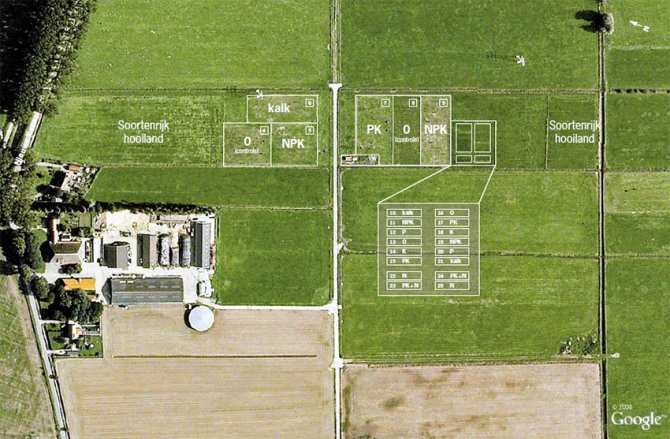
Valuable data has been derived from the Ossekampen Grassland Experiment, a unique experiment near Wageningen. Knowledge is also tested and put into practice at the De Marke experimental farm and on commercial farms. In De Marke, we have set up a network of different ecological elements. The property has been made accessible to the public by means of a 5-km nature trail: the Markepad.
Species-rich grasslands
On a total of approximately 1 million hectares of grassland in the Netherlands, only 3% can be considered species-rich. In the early 50s of last century, this was still more than 50%. This shows how drastically biodiversity has declined on permanent grasslands. However, species-rich grasslands are still an important habitat for flora and fauna. For meadow birds, these grasslands are essential in providing adequate food (insects) for their chicks. Species-rich grass also provides healthy roughage, rich in minerals and fibre, which can be incorporated perfectly into the ration of dairy cattle.
Nature conservation on farm land
Nature conservation on farm land is one of the most important tools to maintain and improve biodiversity in rural areas. It addresses the care required for major bird species on grassland and arable land, botanical grassland management and management of field margins and landscape features. The effectiveness of these agri-ecological areas can be increased by improving spatial coherence and enhancing the so-called green/blue interconnectivity.The policy governing nature conservation on farm land is to make it more result-oriented, efficient and cost-effective. Collectives of agrarian nature conservation organisations are going to shape the future of nature and landscape conservation on farmland. Agrosystems Research is closely involved in a consulting role in one of these: VALA, Agricultural Landscape Association in the Achterhoek.
- Unfortunately, your cookie settings do not allow videos to be displayed. - check your settings
Want to know more about biodiversity and agrarian nature conservation?
Social farming
Some farmers open their doors to people who benefit from a stay in a green environment. In placing their green surroundings at the disposal of others, these farmers fulfil an important social responsibility, and it brings in some extra income. These days, business in agriculture and horticulture is more than just the production and marketing of agricultural products. The farmer, man or woman, is an entrepreneur in a playing field where multiple goals must be achieved, such as caring for nature and the environment.
Combination agriculture and healthcare
Some farmers take it a step further and open their doors to people who, for whatever reason, need or benefit from a stay in a green environment. In placing their pleasant surroundings at the disposal of others, they fulfil an important social responsibility. And – not unimportantly – it brings in some extra income.
Care givers, clients and health authorities
The combination of agriculture and healthcare may seem obvious - there are hundreds of social farms in the Netherlands after all – but their performance is not always adequate. Social farmers have different aspirations and abilities in their role as caregiver. Clients come with a variety of (more or less severe) care needs and health authorities demand guarantees regarding effectiveness and cost efficiency.
Research from different perspectives
In our research, we address these issues, both from the perspective of the care farmer, the client and the care authority. We work together with a variety of organisations. In addition to farming, we are increasingly focusing on citizens' initiatives in the management of green spaces, even in the urban environment.
Read more about social farming
- SoFarTEAM-project (Social Work in Farming)
- Focus Group 'Social farming and innovations'
- Resource article: The benefits of care farms
Want to know more about social farming?
International research in LUF
International research within LUF (and a few colleagues from other AGRO teams) focusses on global challenges such as climate change, biodiversity loss, resource scarcity, food and nutrition security and the energy transition. To study these challenges, we apply different types of quantitative models ranging from crop growth models to resource optimization models, unlock, combine and analyze global databases. We equally apply experimental and integrated food systems approaches to identify options, reveal synergies and minimize tradeoffs. This work is often done in close collaboration with a range of stakeholders. Our domains are agroecosystems from field to global scale, from smallholders to large scale entrepreneurs, in low to middle income countries in Asia, Africa and the Americas.

Typical topics that we address in an international context are crop yield gap analyses, impacts of climate change on crop production, development of climate adaptation and mitigation options, Carbon footprints and Life Cycle Analyses of food and non-food crops, including biofuels, biobased economy, saline agriculture and food and nutrition security analyses.
We conduct research for governments, multilateral organizations, foundations, NGO’s and the private sector. Research outcomes vary from food systems diagnosis, feasibility and crop suitability studies for agricultural and rural development, policy support and advice for improving food security, strategic decision support of companies, to the development and implementation of tools and methods for sustainable land use. We produce reports, peer-reviewed scientific papers, practitioner guides and videos.
Examples of international projects
- Geodata to control potato late blight in Bangladesh
- Land suitability studies
- A healthy diet for a growing population: a case study of Arua, Uganda
- Integrated analysis of opportunities and trade-offs for mixed crop-livestock farm types in Amhara, Ethiopia
Want to know more?
Transformative approaches: agroecology, regeneration and organic farming
We are researching holistic and transformative approaches for farming, food, feed and fiber systems. In the targeted systems, people work together to create and nourish a living environment which is characterized by adequate agricultural livelihoods for new and incumbent farmers, agricultural practices that are intertwined with biodiversity and nature, and offering access to widely valued products and services. We explore integrative, transdisciplinary methods and strengthen the transformative capacity of diverse actors.
We use the ambitions, interests and underlying challenges of agroecological farmers as the starting point for our research. We combine agronomic, ecological, social and transition knowledge. For instance, one important barrier for first-generation agroecological farmers is land security. We built a research agenda from the perspective of agroforestry farmers. We conducted mappings of agroecological players, and studied what farmers drive into agroecological farming.
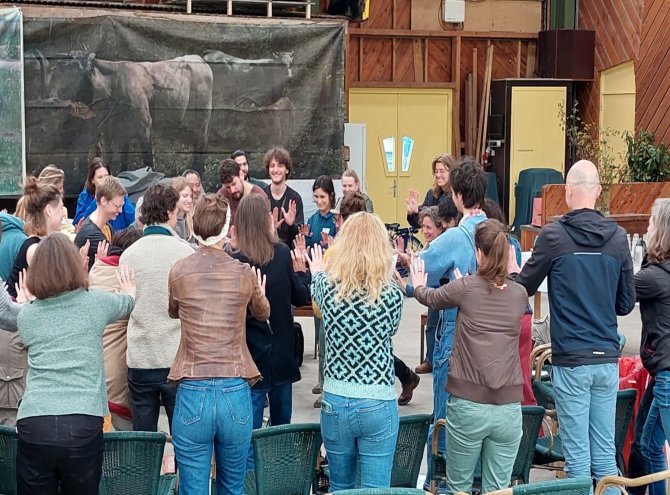
In regenerative thinking and acting, the place with its people and its potential is at the center of our attention. We consider power relations of diverse actors and strive to improve self-reliance, thus going beyond the restoration or maintenance of situations and capacities. For instance, we design and test approaches to advance regenerative, inclusive food systems.
In our systems analyses we use mappings, integrated assessments, ethnography and qualitative modelling to, for instance, estimate the impact of innovative measures. This includes the wanted and unwanted side effects. A major focus is on biodiversity and ecosystem services as important elements in agroecological and other holistic approaches such as organic farming and regenerative perspectives. We work together with diverse partners to design the required steps in the transition to the targeted food and farming systems.
More about transformative approaches
- Making the connections in food provisioning (NWO project)
- Project: Regenerative agriculture in the Netherlands (Re-Ge-NL)
- SENSE project: Synergies in integrated systems (ERA-Net project)
- Goris, M, Bakker, E, Van den Berg, L, Siegmund-Schultze, M, O’ Keeffe, S, Ravesloot, M, Bufe, C, Hassink, J (2024) Collective land arrangements that decommodify land for agroecological transformations. Elemental Science of the Anthropocene. 12 (1): 00061
- Rastorgueva N, Bassignana CF, Angarita E, Fasso A, Hassink J, Goris M, Schmutz U, Conroy J, Dinç S, Wezel A, Migliorini P (2023) Agroecological Living Labs as entry points for agroecological transition: a novel framework for the evaluation of living labs at different scales. Paper presented at Agroecology Europe Forum, 16-18 November 2023, Gyöngös, Hungary.
- Bakker E, Hassink J, van Veluw K (2023) The ‘inner’ dimension of Dutch farmers’ trajectories of change: Drivers, triggers and turning points for sustained agroecological practices. Agroecology and Sustainable Food Systems 47:687-717.
- : Mapping agroecology in the Netherlands (AE4EU project). Pages 186-230 in: Wezel A, Grard B, Kamilia K, Gkisakis V (eds) (2024) Mapping the development of agroecology in Europe - Volume 2. Zenodo.
- Unfortunately, your cookie settings do not allow videos to be displayed. - check your settings
- Unfortunately, your cookie settings do not allow videos to be displayed. - check your settings
